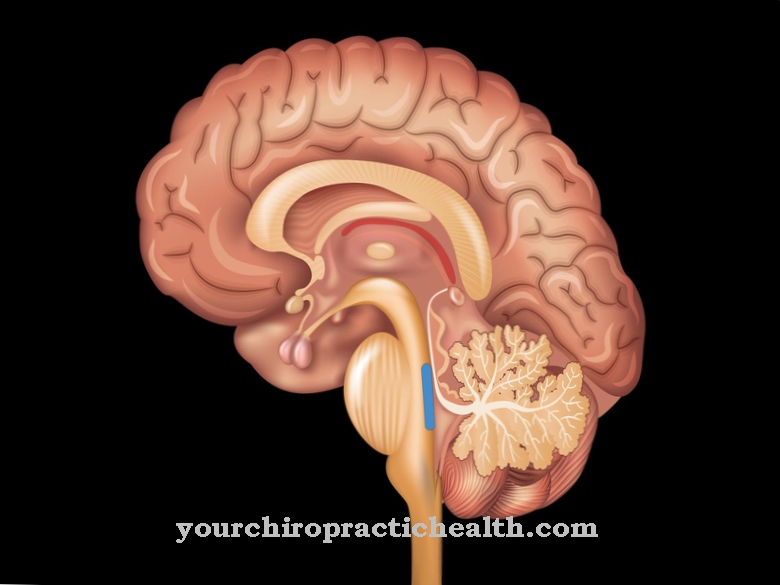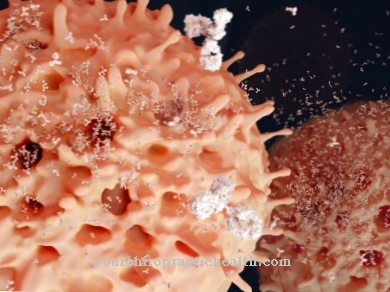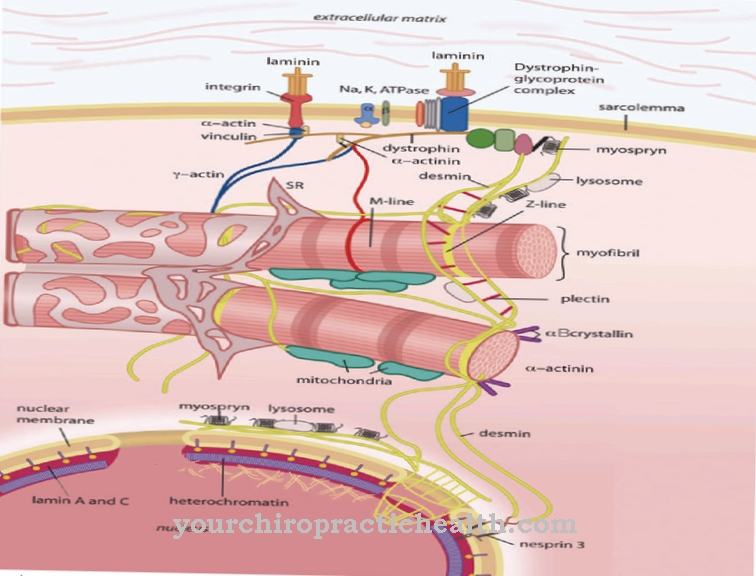Secondary Cilia are freely movable cell processes, as found in the ciliated epithelium of the lungs. Their movements enable the transport of mucus and liquids. In diseases such as asthma or cystic fibrosis, this transport is disturbed by cilia.
What are cilia
The technical terminology describes freely movable cell processes as cilia. These five to ten µm long plasma membrane protuberances are around 0.25 µm slim and contain cytoplasm. Their skeleton is equipped with an axoneme that contains microtubules. All cilia are firmly anchored by fine fibers in the basal body of the pointed cytoplasm.
The eyelashes or cilia are cilia, for example. However, cilia can also be found in the fallopian tubes, in the testes or in the airways. In addition to primary cilia, there are secondary cilia. They differ in the number of microtubules they contain and in their ability to move. Together with the flagella, cilia are also grouped under the collective term undulipodium because of their similar construction principle.
In ciliates, whole groups of cilia are sometimes called cirrus. A distinction must be made between cilia and microvilli. For example, they occur in the intestine and do not have a microtubule structure. The flagella of bacteria cannot be compared with cilia either. They work like a ship's propeller, are significantly smaller than cilia and are not enclosed in a membrane.
Anatomy & structure
Cilia are enclosed on the outside by a plasma membrane. The axoneme separates them from the cell body. The axoneme is a thread made of the contractile proteins dynein and kinesin. The proteins enable the cilia to move. The microtubules are fine hollow fibers on the axoneme. They consist of molecular compounds with an electrical charge and thus each have a positive and a negative tubule.
Each microtubule doublet is thus divided into an A and a B tubule. Each A-tubule is equipped with arm-like structures. These structures are always aligned with the B-tubule of the neighboring iliac. The microtubules of a cilia are arranged twice. These microtubule doublets of the tubular ciliary skeleton are arranged in a circular arrangement. In the middle of this circle there are two central microtubules in some cilia. These cilia are also called secondary cilia.
In contrast, medicine calls cilia without central microtubules primary cilia. Inside there is cytoplasm, which forms the cytoskeleton of the cilia and thus generates the axoneme. The individual microtubule doublets are connected to one another by nexin links. In the case of secondary cilia, the decentralized doublets are also networked with the central doublet via radial spokes.
Function & tasks
Secondary cilia are usually capable of active striking or rowing movements. They can stretch and bend by tensing their microtubules. So a sliding mechanism occurs. The bend of the cilia occurs when the arm of the A tubule makes contact with the B tubule of the neighboring cilia and moves the tubules of the tubule doublet against each other. The highly flexible protein nexin keeps the neighboring doublets of the cilia together during this shift. As the cilia suggests, it is stretched.
While it strikes back, it is bent. Secondary cilia are usually arranged in large masses and move in a coordinated manner according to the principle just described. This means that the opposite rows of a row of cilia each deflect a fraction later. This principle of movement is also called metachronic movement. This creates an evenly beating flicker current on the surface of the cilia group, which runs in waves. In a warm-blooded animal, the cilia beat frequency is around 20 per second. In humans, the coordinated movements of the secondary cilia are generally used to transport fluid and mucous films in the organism.
For example, the egg cell is transported in the fallopian tube or the mucus is transported in the bronchi. In ciliates, the movement serves to move the individual cells. In connection with the sperm of higher animal species, the ciliary movement is responsible for cell locomotion. Sometimes the movement of the secondary cilia is also used for the spinning of food. Primary cilia are usually incapable of active movement. Primary cilia, unlike the secondary ones, usually do not move, but take on the function of a sensory antenna. They are found primarily in the visual apparatus and the olfactory system.
You can find your medication here
➔ Medication for shortness of breath and lung problemsDiseases
Various circumstances can paralyze the ciliary movement of the secondary cilia. Such paralysis can occur particularly in relation to the ciliated epithelium of the lungs. For example, if the pH falls below 6.4 or exceeds nine, then paralysis occurs. Allergic mechanisms can also stop the movement of the cilia. For example, it happens in asthma that the cilia in the lungs cannot beat at the moment.
In the case of the metabolic disorder cystic fibrosis, such paralysis of the pulmonary cilia also occurs. Physical or mechanical damage to the cilia may also be responsible for paralysis or movement disorders. High temperatures or cold can trigger a physical disorder. Air turbulence, on the other hand, is one of the most common causes of mechanical damage. Medicine understands ciliary dysfunction as a general malfunction of the cilia.
Primary ciliary dysfunction can occur, for example, in the context of diseases such as Kartagener's syndrome. A secondary ciliary dysfunction of the lungs, on the other hand, could occur if the person concerned has inhaled harmful substances. In the case of chronic paralysis of the ciliary movement, the ciliated epithelium may turn into a squamous epithelium. This means that the mucus can no longer be transported out of the lungs. This phenomenon is common in heavy smokers, but the diseases just mentioned can also be associated with it.
























.jpg)



